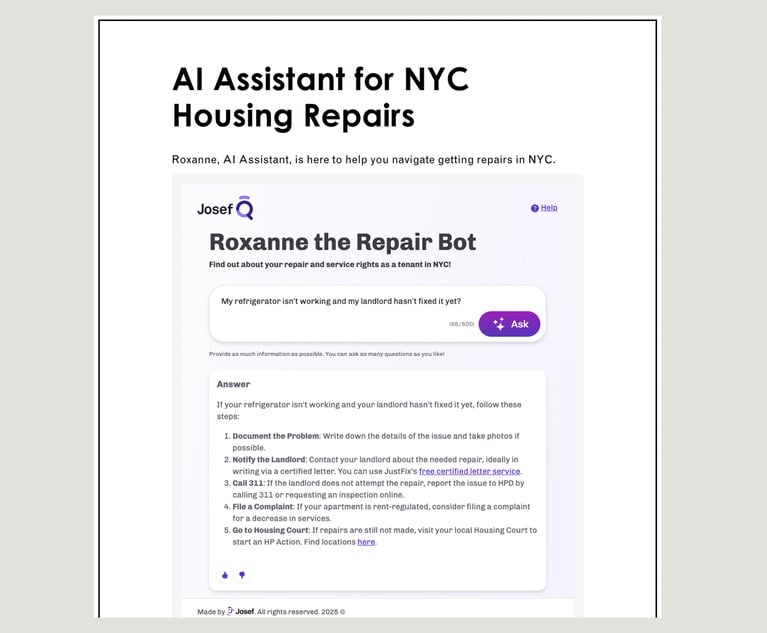SCOTUS Action on DACA Looms as Second Circuit Hears Mandamus Oral Arguments
The appellate panel heard arguments on the mandamus petition before it over U.S. District Judge Nicholas Garaufis' order to have the government proceed with document production and discovery in the suit over the federal wind down of DACA.
December 14, 2017 at 05:13 PM
9 minute read
 U.S. Court of Appeals for the Second Circuit.
U.S. Court of Appeals for the Second Circuit.
Should the U.S. Court of Appeals for the Second Circuit hold off on a mandamus petition by the government until the U.S. Supreme Court decides on a similar suit coming out of California over the Trump administration's wind down of the Deferred Action for Childhood Arrivals?
That question loomed behind the granular-level debate Thursday over a mandamus petition before the panel of Circuit Judges Barrington Parker, Gerard Lynch and Christopher Droney in In Re: Elaine Duke, 17-3345. The judges—most notably the probing Lynch—grilled the government over its underlying arguments as to why U.S. District Judge Nicholas Garaufis of the Eastern District of New York had so gone beyond his prerogative as to require mandamus.
Deputy Assistant U.S. Attorney General Hashim Mooppan reiterated the government's points before the panel, that the district court erred by moving forward with the administrative record document production and discovery sought by plaintiffs. The core of the argument under the Administrative Procedure Act, which the government contends blocks review of its deliberative process.
The documents sought by plaintiffs “simply aren't part of the administrative record,” Mooppan told the panel Thursday.
The panel, led largely by Lynch, sought to open up the government's position, even as many of the initial questions sought clarity on the government's underlying arguments, rather than specifically targeting the explicit error that required the appellate court to intercede.
Mooppan defended the government's position to dismantle the DACA program was made, in substantive part, over legal concerns—specifically, that it was all but certain to be struck down by federal courts anyway, so keeping it made little sense.
Lynch and the other judges pressed Mooppan on how a court was to determine if that legal calculation had been done arbitrarily and capriciously if it was unable to review the information that went into the decision. What if the government officials were “cherry-picking” information that supported a predetermined outcome, rather than based on a full reading of all the information before it?
Mooppan reiterated that the fact that the decision was a deliberative one, and not subject to review by the courts, meant that it was insignificant as to what pieces of information were being reviewed.
Lynch went on to question Mooppan as to why the government had brought the mandamus writ so quickly, before exhausting its options, such as protective orders, at the district level, since things were clearly at such an early stage.
Plaintiffs, too, were quizzed by the judges, who wondered why the DACA decision was any different than other “prosecutorial discretion” issues facing the DOJ on a regular basis. Lynch used the example of federal prosecutors previously declining to go after marijuana cases in states that had legalized the drug, before reversing course under the current administration.
Joshua Rosenthal, an attorney with the National Immigration Law Center, represented the private Batalla Vidal plaintiffs. He said the distinction was, in part, because the decision to end DACA didn't amount to discretion, as much as a hard end to a government policy.
The plaintiffs also saw the question of just how the Second Circuit should operate given the Ninth Circuit writ before the Supreme Court rise prominently. Currently, document production and discovery is stayed in the district and appellate courts in California, pending a decision by the Supreme Court on a mandamus petition before it in that case. The Ninth Circuit earlier this month denied a mandamus petition in that parallel DACA case by the government, that would have allowed that case to go forward.
Judge Christopher Droney expressed questions about the “flexibility” the Second Circuit had, given the questions still outstanding on the California actions.
All parties agreed that while similar, the two cases had significant and discernible differences. For example, plaintiffs in the California suit had included documents from the White House in their production request, which wasn't the case in the New York suit. Additionally, the district court in New York had already done more to limit the number of layers of bureaucracy that would potentially be exposed to having to produce documents.
New York Deputy Solicitor General Anisha Dasgupta represented the state plaintiffs before the panel. While she agreed the Supreme Court's decision had the potential to impact the New York case, she argued that the current case was so early in its deliberations that the appellate court could not step in to stop the production of documents and discovery—actions that the court had every right to proceed with.
“This is not about deliberative material,” Dasgupta said, arguing that the appellate court should allow the process in the lower court to go forward.
 U.S. Court of Appeals for the Second Circuit.
U.S. Court of Appeals for the Second Circuit.
Should the U.S. Court of Appeals for the Second Circuit hold off on a mandamus petition by the government until the U.S. Supreme Court decides on a similar suit coming out of California over the Trump administration's wind down of the Deferred Action for Childhood Arrivals?
That question loomed behind the granular-level debate Thursday over a mandamus petition before the panel of Circuit Judges Barrington Parker, Gerard Lynch and Christopher Droney in In Re: Elaine Duke, 17-3345. The judges—most notably the probing Lynch—grilled the government over its underlying arguments as to why U.S. District Judge Nicholas Garaufis of the Eastern District of
Deputy Assistant U.S. Attorney General Hashim Mooppan reiterated the government's points before the panel, that the district court erred by moving forward with the administrative record document production and discovery sought by plaintiffs. The core of the argument under the Administrative Procedure Act, which the government contends blocks review of its deliberative process.
The documents sought by plaintiffs “simply aren't part of the administrative record,” Mooppan told the panel Thursday.
The panel, led largely by Lynch, sought to open up the government's position, even as many of the initial questions sought clarity on the government's underlying arguments, rather than specifically targeting the explicit error that required the appellate court to intercede.
Mooppan defended the government's position to dismantle the DACA program was made, in substantive part, over legal concerns—specifically, that it was all but certain to be struck down by federal courts anyway, so keeping it made little sense.
Lynch and the other judges pressed Mooppan on how a court was to determine if that legal calculation had been done arbitrarily and capriciously if it was unable to review the information that went into the decision. What if the government officials were “cherry-picking” information that supported a predetermined outcome, rather than based on a full reading of all the information before it?
Mooppan reiterated that the fact that the decision was a deliberative one, and not subject to review by the courts, meant that it was insignificant as to what pieces of information were being reviewed.
Lynch went on to question Mooppan as to why the government had brought the mandamus writ so quickly, before exhausting its options, such as protective orders, at the district level, since things were clearly at such an early stage.
Plaintiffs, too, were quizzed by the judges, who wondered why the DACA decision was any different than other “prosecutorial discretion” issues facing the DOJ on a regular basis. Lynch used the example of federal prosecutors previously declining to go after marijuana cases in states that had legalized the drug, before reversing course under the current administration.
Joshua Rosenthal, an attorney with the National Immigration Law Center, represented the private Batalla Vidal plaintiffs. He said the distinction was, in part, because the decision to end DACA didn't amount to discretion, as much as a hard end to a government policy.
The plaintiffs also saw the question of just how the Second Circuit should operate given the Ninth Circuit writ before the Supreme Court rise prominently. Currently, document production and discovery is stayed in the district and appellate courts in California, pending a decision by the Supreme Court on a mandamus petition before it in that case. The Ninth Circuit earlier this month denied a mandamus petition in that parallel DACA case by the government, that would have allowed that case to go forward.
Judge Christopher Droney expressed questions about the “flexibility” the Second Circuit had, given the questions still outstanding on the California actions.
All parties agreed that while similar, the two cases had significant and discernible differences. For example, plaintiffs in the California suit had included documents from the White House in their production request, which wasn't the case in the
“This is not about deliberative material,” Dasgupta said, arguing that the appellate court should allow the process in the lower court to go forward.
This content has been archived. It is available through our partners, LexisNexis® and Bloomberg Law.
To view this content, please continue to their sites.
Not a Lexis Subscriber?
Subscribe Now
Not a Bloomberg Law Subscriber?
Subscribe Now
NOT FOR REPRINT
© 2025 ALM Global, LLC, All Rights Reserved. Request academic re-use from www.copyright.com. All other uses, submit a request to [email protected]. For more information visit Asset & Logo Licensing.
You Might Like
View All
Meet the Long Island Judge Tapped to Be US Attorney for Eastern District of New York
2 minute read
New York’s Property Tax Incentives and Abatements Make Development Feasible
7 minute read
Josef Partners With NYU, Housing Court Answers to Launch AI Assistant Built for Tenants

Trending Stories
Who Got The Work
Michael G. Bongiorno, Andrew Scott Dulberg and Elizabeth E. Driscoll from Wilmer Cutler Pickering Hale and Dorr have stepped in to represent Symbotic Inc., an A.I.-enabled technology platform that focuses on increasing supply chain efficiency, and other defendants in a pending shareholder derivative lawsuit. The case, filed Oct. 2 in Massachusetts District Court by the Brown Law Firm on behalf of Stephen Austen, accuses certain officers and directors of misleading investors in regard to Symbotic's potential for margin growth by failing to disclose that the company was not equipped to timely deploy its systems or manage expenses through project delays. The case, assigned to U.S. District Judge Nathaniel M. Gorton, is 1:24-cv-12522, Austen v. Cohen et al.
Who Got The Work
Edmund Polubinski and Marie Killmond of Davis Polk & Wardwell have entered appearances for data platform software development company MongoDB and other defendants in a pending shareholder derivative lawsuit. The action, filed Oct. 7 in New York Southern District Court by the Brown Law Firm, accuses the company's directors and/or officers of falsely expressing confidence in the company’s restructuring of its sales incentive plan and downplaying the severity of decreases in its upfront commitments. The case is 1:24-cv-07594, Roy v. Ittycheria et al.
Who Got The Work
Amy O. Bruchs and Kurt F. Ellison of Michael Best & Friedrich have entered appearances for Epic Systems Corp. in a pending employment discrimination lawsuit. The suit was filed Sept. 7 in Wisconsin Western District Court by Levine Eisberner LLC and Siri & Glimstad on behalf of a project manager who claims that he was wrongfully terminated after applying for a religious exemption to the defendant's COVID-19 vaccine mandate. The case, assigned to U.S. Magistrate Judge Anita Marie Boor, is 3:24-cv-00630, Secker, Nathan v. Epic Systems Corporation.
Who Got The Work
David X. Sullivan, Thomas J. Finn and Gregory A. Hall from McCarter & English have entered appearances for Sunrun Installation Services in a pending civil rights lawsuit. The complaint was filed Sept. 4 in Connecticut District Court by attorney Robert M. Berke on behalf of former employee George Edward Steins, who was arrested and charged with employing an unregistered home improvement salesperson. The complaint alleges that had Sunrun informed the Connecticut Department of Consumer Protection that the plaintiff's employment had ended in 2017 and that he no longer held Sunrun's home improvement contractor license, he would not have been hit with charges, which were dismissed in May 2024. The case, assigned to U.S. District Judge Jeffrey A. Meyer, is 3:24-cv-01423, Steins v. Sunrun, Inc. et al.
Who Got The Work
Greenberg Traurig shareholder Joshua L. Raskin has entered an appearance for boohoo.com UK Ltd. in a pending patent infringement lawsuit. The suit, filed Sept. 3 in Texas Eastern District Court by Rozier Hardt McDonough on behalf of Alto Dynamics, asserts five patents related to an online shopping platform. The case, assigned to U.S. District Judge Rodney Gilstrap, is 2:24-cv-00719, Alto Dynamics, LLC v. boohoo.com UK Limited.
Featured Firms
Law Offices of Gary Martin Hays & Associates, P.C.
(470) 294-1674
Law Offices of Mark E. Salomone
(857) 444-6468
Smith & Hassler
(713) 739-1250






